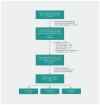Mortality among patients with frequent emergency department use for alcohol-related reasons in Ontario: a population-based cohort study
- PMID: 33229348
- PMCID: PMC7721258
- DOI: 10.1503/cmaj.191730
Mortality among patients with frequent emergency department use for alcohol-related reasons in Ontario: a population-based cohort study
Abstract
Background: Little is known about the risk of death among people who visit emergency departments frequently for alcohol-related reasons, including whether mortality risk increases with increasing frequency of visits. Our primary objective was to describe the sociodemographic and clinical characteristics of this high-risk population and examine their 1-year overall mortality, premature mortality and cause of death as a function of emergency department visit frequency in Ontario, Canada.
Methods: We conducted a population-based retrospective cohort study using linked health administrative data (Jan. 1, 2010, to Dec. 31, 2016) in Ontario for people aged 16-105 years who made at least 2 emergency department visits for mental or behavioural disorders due to alcohol within 1 year. We subdivided the cohort based on visit frequency (2, 3 or 4, or ≥ 5). The primary outcome was 1-year mortality, adjusted for age, sex, income, rural residence and presence of comorbidities. We examined premature mortality using years of potential life lost (YPLL).
Results: Of the 25 813 people included in the cohort, 17 020 (65.9%) had 2 emergency department visits within 1 year, 5704 (22.1%) had 3 or 4 visits, and 3089 (12.0%) had 5 or more visits. Males, people aged 45-64 years, and those living in urban centres and lower-income neighbourhoods were more likely to have 3 or 4 visits, or 5 or more visits. The all-cause 1-year mortality rate was 5.4% overall, ranging from 4.7% among patients with 2 visits to 8.8% among those with 5 or more visits. Death due to external causes (e.g., suicide, accidents) was most common. The adjusted mortality rate was 38% higher for patients with 5 or more visits than for those with 2 visits (adjusted hazard ratio 1.38, 95% confidence interval 1.19-1.59). Among 25 298 people aged 16-74 years, this represented 30 607 YPLL.
Interpretation: We observed a high mortality rate among relatively young, mostly urban, lower-income people with frequent emergency department visits for alcohol-related reasons. These visits are opportunities for intervention in a high-risk population to reduce a substantial mortality burden.
© 2020 Joule Inc. or its licensors.
Conflict of interest statement
Competing interests: None declared.
Figures


Similar articles
-
Subgroups of people who make frequent emergency department visits in Ontario and Alberta: a retrospective cohort study.CMAJ Open. 2022 Mar 15;10(1):E232-E246. doi: 10.9778/cmajo.20210132. Print 2022 Jan-Mar. CMAJ Open. 2022. PMID: 35292481 Free PMC article.
-
Rates of emergency department visits attributable to alcohol use in Ontario from 2003 to 2016: a retrospective population-level study.CMAJ. 2019 Jul 22;191(29):E804-E810. doi: 10.1503/cmaj.181575. CMAJ. 2019. PMID: 31332048 Free PMC article.
-
People who make frequent emergency department visits based on persistence of frequent use in Ontario and Alberta: a retrospective cohort study.CMAJ Open. 2022 Mar 15;10(1):E220-E231. doi: 10.9778/cmajo.20210131. Print 2022 Jan-Mar. CMAJ Open. 2022. PMID: 35292480 Free PMC article.
-
Socioeconomic and Geographic Disparities in Emergency Department Visits due to Alcohol in Ontario: A Retrospective Population-level Study from 2003 to 2017.Can J Psychiatry. 2022 Jul;67(7):534-543. doi: 10.1177/07067437211027321. Epub 2021 Jul 13. Can J Psychiatry. 2022. PMID: 34254563 Free PMC article.
-
Temporal Trends and Predictors of Thirty-Day Readmissions and Emergency Department Visits Following Total Knee Arthroplasty in Ontario Between 2003 and 2016.J Arthroplasty. 2020 Feb;35(2):364-370. doi: 10.1016/j.arth.2019.09.015. Epub 2019 Sep 14. J Arthroplasty. 2020. PMID: 31732370 Review.
Cited by
-
Acute injury mortality and all-cause mortality following emergency department presentation for alcohol use disorder.Drug Alcohol Depend. 2022 Jul 1;236:109472. doi: 10.1016/j.drugalcdep.2022.109472. Epub 2022 Apr 25. Drug Alcohol Depend. 2022. PMID: 35490593 Free PMC article.
-
[Black box: Attenders with psychosocial needs in the emergency department].Med Klin Intensivmed Notfmed. 2024 Feb;119(1):10-17. doi: 10.1007/s00063-022-00981-x. Epub 2023 Jan 12. Med Klin Intensivmed Notfmed. 2024. PMID: 36635440 Free PMC article. German.
-
Subgroups of people who make frequent emergency department visits in Ontario and Alberta: a retrospective cohort study.CMAJ Open. 2022 Mar 15;10(1):E232-E246. doi: 10.9778/cmajo.20210132. Print 2022 Jan-Mar. CMAJ Open. 2022. PMID: 35292481 Free PMC article.
-
SARS-CoV-2 vaccination prevalence by mental health diagnosis: a population-based cross-sectional study in Ontario, Canada.CMAJ Open. 2023 Nov 21;11(6):E1066-E1074. doi: 10.9778/cmajo.20220210. Print 2023 Nov-Dec. CMAJ Open. 2023. PMID: 37989512 Free PMC article.
-
Outcomes in Clinical Subgroups of Patients With Alcohol-Related Hospitalizations.JAMA Netw Open. 2024 Jan 2;7(1):e2353971. doi: 10.1001/jamanetworkopen.2023.53971. JAMA Netw Open. 2024. PMID: 38294814 Free PMC article.
References
-
- Rehm J, Mathers C, Popova S, et al. Global burden of disease and injury and economic cost attributable to alcohol use and alcohol-use disorders. Lancet 2009;373:2223–33. - PubMed
-
- Global status report on alcohol and health 2018. Geneva: World Health Organization; 2018.
-
- GBD 2016 Risk Factors Collaborators. Global, regional, and national comparative risk assessment of 84 behavioural, environmental and occupational, and metabolic risks or clusters of risks, 1990–2016: a systematic analysis for the Global Burden of Disease Study 2016. Lancet 2017;390:1345–422. - PMC - PubMed
-
- Alcohol harm in Canada: examining hospitalizations entirely caused by alcohol and strategies to reduce alcohol harm. Ottawa: Canadian Institute for Health Information; 2017.
-
- Rehm JBD, Brochu S, Fischer B, et al. The costs of substance abuse in Canada 2002. Ottawa: Canadian Centre on Substance Abuse; 2006.
MeSH terms
LinkOut - more resources
Full Text Sources
Medical
Research Materials
